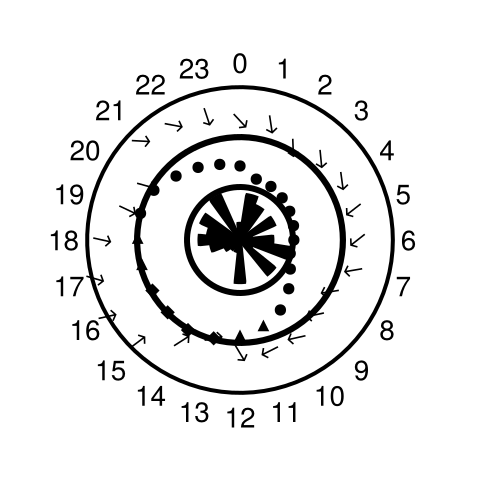Log 05: August 3rd, 2025 - Seeing the Vision ![]()
AT LAST! I posted another discussion over
in Discourse about How To Make Concentric Polar Axes with Custom Band Size in Makie? and thanks to some pointers from @jules and tinkering by @JonasWickman, I was able to get the vision of my Polar weather plot working:
Many thanks for the support from folks on the help! Also, I had to update and figure out how to hack out the radial bar plot hack using CairoMakie.jl based on the following post: Wind Rose 'hard' stacked barplot edges in GLMakie - #2 by ffreyer and solution by @ffreyer. To create a figure like this, the code (with updates to the Makie interface) is here:
using CairoMakie
using Luxor
f = Figure(
size = (240, 240)
);
function scale_vals(data, r)
r_min = minimum(data)
r_max = maximum(data)
t_min = r[1]
t_max = r[2]
[(m - r_min)/(r_max - r_min) * (t_max - t_min) + t_min for m in data]
end
# Outside ring
ax = PolarAxis(
f[1, 1],
width = 200,
height = 240,
rminorgridvisible = false,
rminorticksvisible = false,
rgridvisible = false,
rticks = LinearTicks(2),
rticklabelsize = 10,
rticklabelsvisible = false,
rgridcolor = :blue,
rlimits = (6.66, 10),
thetaminorticksvisible = false,
thetaticks = (collect(-3pi/2:15 * pi / 180:pi/2)[1:end-1], vcat("0", ["$x" for x in 23:-1:1])),
thetaticklabelsize = 14,
thetaminorticks = IntervalsBetween(3),
thetagridcolor = :black,
thetagridvisible = false,
thetagridwidth = 1,
clip = false
)
scatter!(ax, collect(-3pi/2:15 * pi / 180:pi/2)[1:end-1], scale_vals(reverse(hourly_vars["wind_speed_10m"]), ax.rlimits.val), color = :black, markersize = 12, marker = '↑', rotation = hourly_vars["wind_direction_10m"] .* (pi / 180))
# Middle ring
ax = PolarAxis(
f[1, 1],
width=120,
height=120,
rminorgridvisible = false,
rminorticksvisible = false,
rgridvisible = false,
rticks = LinearTicks(2),
rticklabelsize = 10,
rticklabelsvisible = false,
rgridcolor = :blue,
rlimits = (3.33, 6.66),
thetaminorticksvisible = false,
thetaticks = (collect(-3pi/2:15 * pi / 180:pi/2)[1:end-1], vcat("0", ["$x" for x in 23:-1:1])),
thetaticklabelsize = 10,
thetaticklabelsvisible = false,
thetaminorticks = IntervalsBetween(3),
thetagridcolor = :black,
thetagridvisible = false,
thetagridwidth = 1,
clip = false,
)
norm_val = ax.rlimits.val[1] / minimum(hourly_vars["temperature_2m"])
scatter!(ax, collect(-3pi/2:15 * pi / 180:pi/2)[1:end-1], scale_vals(reverse(hourly_vars["temperature_2m"]), ax.rlimits.val), color = :black, markersize = 8, marker = markers)
# Inside ring
ax = PolarAxis(
f[1,1];
width=70,
height=70,
rlimits = (0, 3.33),
rminorgridvisible = false,
rminorticksvisible = false,
rgridvisible = false,
rticks = LinearTicks(2),
rticklabelsize = 10,
rticklabelsvisible = false,
rgridcolor = :blue,
thetaminorticksvisible = false,
thetaticks = (collect(-3pi/2:15 * pi / 180:pi/2)[1:end-1], vcat("0", ["$x" for x in 23:-1:1])),
thetaticklabelsvisible = false,
thetaminorticks = IntervalsBetween(3),
thetagridcolor = :black,
thetagridvisible = false,
thetagridwidth = 1,
clip = false,
);
p = barplot!(ax, collect(-3pi/2:15 * pi / 180:pi/2)[1:end-1], rand(0:.1:3.33, 24))
pp = popat!(p.plots, findfirst(x -> x isa Poly, p.plots))
polys = map(pp[1].value) do rects
map(rects) do rect
N_steps = 100
mini = minimum(rect); maxi = maximum(rect)
ps = Point2f[mini, Point2f(mini[1], maxi[2]), maxi, Point2f(maxi[1], mini[2]), mini]
ps = map(range(0, 4, length = N_steps)) do f
ps[1] * max(0, 1-f) +
ps[2] * max(0, 1 - abs(f-1)) +
ps[3] * max(0, 1 - abs(f-2)) +
ps[4] * max(0, 1 - abs(f-3)) +
ps[5] * max(0, 1 - abs(f-4))
end
Makie.Polygon(ps)
end
end
poly!(p, attributes(pp), polys[1], strokecolor = :black, strokewidth = 2, color = :black)
Here’s how it looks on my eink display:
With this part out of the way, I think we now dip back more into software engineering. Basically, what I need to figure out is how to best create a layout-ing engine for my eink display that:
- Keeps track of where components are in a display
- Segments out the display into a grid
- Handles components
The biggest question I have is where to put my tinkerings for components. Probably I’ll make a package like JinkiesComponents that has a bunch of extensions to load different components like for weather, todo lists, calendars, etc.
And with that! We are back to hackings!

